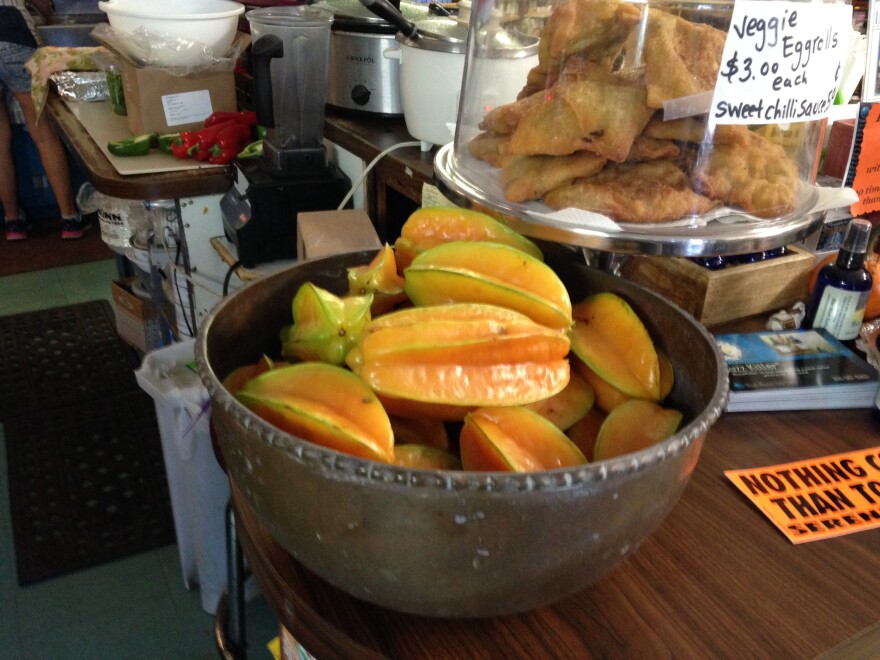Patrick Garvey was working for the state Department of Children and Families four years ago when he got a grant from Volunteer Florida to create an edible garden at a food stamp outreach site in the Florida Keys.
"It was $5,000. It was all volunteers," said Garvey. He was supposed to create one garden and get 50 volunteers.
"We ended up doing 11 gardens and engaging more than 500 volunteers," he said.
Garvey was hooked on the idea of helping people learn how to grow their own food. But he didn't want to do it while working for the state.

"I was almost in my mid-30s and I figured this is my time to try and do something entrepreneurial," Garvey said. He started traveling from the Keys to Homestead to learn about growing food in South Florida. And he formed a nonprofit, the Growing Hope Initiative.
And he started hearing about a two-acre property on Big Pine Key that was for sale. The property was a legend among veteran fruit tree aficionados in South Florida.
It was called the Grimal Grove, named for Adolf Grimal. The machinist and inventor bought the property after he came to the Keys in the 1950s to experiment with underwater 3-D photography. Instead, he became obsessed with growing tropical fruit.
Watch: Patrick Garvey describes one of Grimal Grove's rarest trees, the alupag.
The Florida Keys have the best climate in the continental U.S. for growing tropical fruit, Garvey said. "Even Miami, it's a little colder. So he had that going for him. But we don't have the consistent rains here in the Keys. And we don't have soil. So that's when the engineer took over in him."
Working on his own, Grimal designed and built a rain catchment and irrigation system and brought in soil to build up other parts of the property. "The stories I've heard, sun up to sundown, he's with a pickax, chopping away," Garvey said. "It's kind of like the Coral Castle, but an agricultural kind of Coral Castle."

Grimal collected fruit trees from all over the world, on his own trips and with the help of fellow South Florida fruit collectors. He would open his grove to tours from Fairchild Tropical Botanic Garden and worked with a few other people. But mostly he was on his own, living in a trailer on the property.
After he died in 1997, the grove eventually was abandoned. By the time Garvey came along, it had been overrun with invasive exotics like Brazilian pepper and was inhabited by drug users.
Dale Martin has been spending winters on Big Pine Key for more than 15 years and was saddened to see the grove's decline.
"It was just a terrible place to come around. People were afraid to walk by here, even. It was so overgrown," said Martin. "You didn't know who was in here — or what was in here."
The county had levied code-enforcement fines against the property to the tune of $850,000. But despite the condition of the place, Garvey could just make out Adolf Grimal's grove.
"You kind of had to be a little crazy to have the vision, but you could see pockets of beauty," Garvey said. "It was completely overgrown. But there was some sort of vibe, some sort of, like, spirit. And I just, I couldn't get it out of my mind."

Garvey cashed in his retirement account, found an investor and came up with the down payment. The same week that he closed on the property, his wife gave birth to twin daughters.
Since then, he and a cadre of volunteers have been clearing the property of Brazilian peppers and old tires. They've been cleaning up and patching the old irrigation system and giving the fruit trees enough care that they are producing again.
Garvey provides carambola and other Grimal Grove products to Good Food Conspiracy, a health food store that's been on Big Pine Key for 34 years.
"It's really a miracle that Patrick came down here and this happened, to save this property," said Marney Brown, the store's owner.
Garvey, who majored in history in college, has dual missions for Grimal Grove. Its primary purpose is to share the harvest, and knowledge, about growing tropical fruit and other food in South Florida. The grove now hosts the county's annual Tropical Fruit Fiesta and there are workshops on making chocolate and bath and body products from locally grown plants.
But Garvey also been has unearthing the story of Adolf Grimal, interviewing those who knew him and even traveling to the Amazon to retrace some of Grimal's collecting journeys.
"My blood, sweat and tears are into this, just like his," Garvey said.
And he's starting to see, quite literally, the fruits of his labor.
"When we first got here, there was no flowering, no pods," he said. He points to a cacoa tree."A couple years later now, they're starting to come in through our irrigation. Just the love — so many trees in the last three years, I've seen fruit for the first time."


